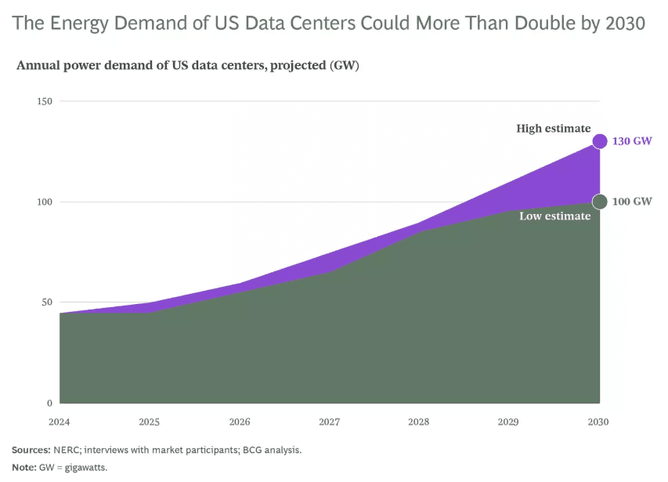BCG report details how industries including construction need to collaborate on AI-driven energy solutions, citing data centre design as an example.
The rapid growth of Generative AI is reshaping the industries including construction, but its soaring energy demands pose a significant challenge to the global fight against climate change, a new report from Boston Consulting Group (BCG) says.
The BCG report examines how these two trends – GenAI development and the energy transition – intersect, pointing out that CEOs must navigate these competing priorities carefully, otherwise unchecked AI expansion could undermine progress toward climate goals.
It adds that collaboration between the tech and energy sectors offers a chance to address these issues together.
Why AI is changing data centre design and construction
Generative AI development is driving a dramatic increase in energy consumption, particularly in the US.
The electricity demand for US data centres alone is expected to grow by 15% to 20% annually, potentially reaching 100 to 130 gigawatt hours by 2030.
To put that into perspective, this amount could power two-thirds of all US households. The scale of this growth is staggering and places immense pressure on existing power grids.
The impact of AI on data centre design and construction is also growing, as the world seeks to meet need for greater AI workloads and networking capabilities. In particular, the cooling demands of AI applications are pushing current data centre design to its limits.
A key concern is the looming shortfall in “firm” power, or reliable energy supply, which could emerge as early as 2026. Data centres are anticipated to contribute more than 60% of the additional power demand in the US through the remainder of the decade.
This rapid surge exposes a bottleneck: while AI development accelerates, energy infrastructure struggles to keep pace. Building new transmission lines, for instance, can take over a decade – far too slow to match the immediate needs of AI hyper-scalers.

Innovative solutions for AI energy use
AI companies are taking proactive steps to address their energy consumption.
Some are investing in smaller, less energy-hungry models that maintain performance while using fewer resources, whilst others are optimising data centre architecture, designing systems that operate more efficiently and reduce waste.
Beyond reducing their own footprints, many AI firms are forming partnerships with energy providers. These collaborations focus on smarter grid management and innovative solutions to enhance overall efficiency.
Such partnerships benefit both sectors – energy companies can scale their operations to meet demand, while AI developers ensure the sustainability of their expansion.
Meanwhile, energy providers face their own challenges. They are under pressure to deploy capital at unprecedented rates to meet demand from AI hyper-scalers. Yet this urgency creates opportunities for long-term agreements and collaborative technology development, which could reshape the energy sector.

“Stay the course on what you need to do to make AI successful – and ensure that you’re keeping an eye on the cleanliness of the power you’re leveraging in your Scope 2 and 3 emissions.” – Vivian Lee, Managing Director & Partner, BCG.
Exploring alternative energy sources
One intriguing development is the growing interest in nuclear power as a sustainable energy source for AI operations.
Microsoft has signed a 20-year agreement with Constellation Energy to restart a reactor at the Three Mile Island plant, a project estimated at US$1.6bn.
Other tech leaders, including Google and Amazon, are investing in small modular reactors (SMRs). These compact nuclear systems offer a cleaner, scalable energy solution and represent a potential game-changer for both the tech and energy industries.
This trend hints at an exciting possibility: AI companies could evolve beyond energy consumers to become drivers of energy innovation – or even energy producers themselves. By pushing boundaries in renewable energy and nuclear technology, these firms could contribute directly to a greener future.
“We can’t ignore the risks around nuclear, but it gives us a line of sight to a scalable solution to deliver more baseload power – and green power at that,” says Maurice Berns, Chair of BCG’s Centre for Energy Impact.
A shared vision for a sustainable future
The BCG report envisions a future energy system that is autonomous, decentralised and waste-free.
Ironically, the very AI technologies creating today’s energy demands could power tomorrow’s sustainable systems. However, achieving this balance requires deliberate action.
To align AI growth with climate goals, leaders are encouraged to:
- Optimise electricity use to mitigate short-term shortages
- Invest in scalable, sustainable energy sources for the long term
- Foster cross-sector collaboration to address challenges and innovate together
Partnerships between the energy and AI sectors are key to unlocking solutions that ensure environmental sustainability while supporting technological progress. By aligning their goals, these industries can create a future that is both advanced and sustainable.



